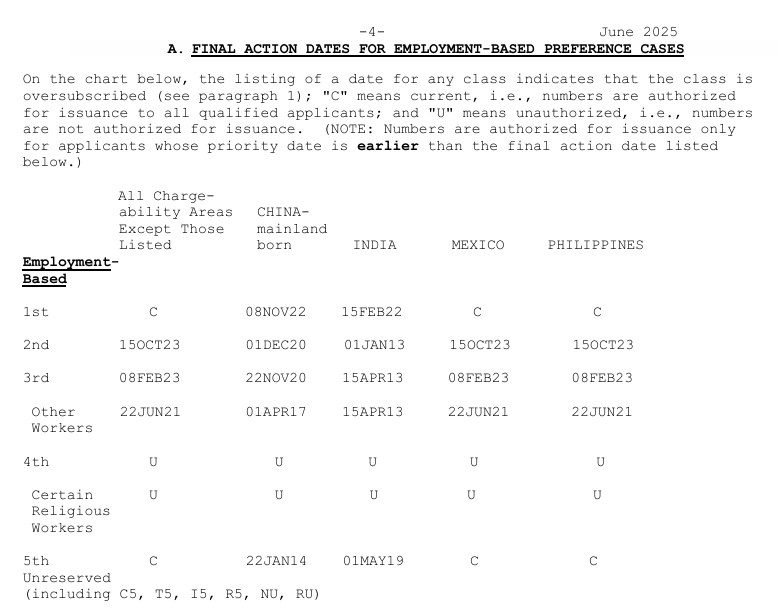June 2025 Visa Bulletin Insights: Mixed Progress Across Employment Categories with Notable EB-2 Advances

The June 2025 Visa Bulletin presents several key developments in both family-based and employment-based immigration categories. First, the highlights- the June 2025 Visa Bulletin indicates stability in most categories with no retrogressions, continued unavailability of EB-4 visas, and some advancements in employment-based categories for certain countries. Family-based applicants must use the Dates for Filing Chart, and there are specific alerts for SIV applicants.
No Retrogression: There are no retrogressions in any category for June 2025.
EB-4 Unavailability: The employment-based fourth preference category remains unavailable.
F2A Category: The F2A category remains unchanged on both the Final Action Chart and the Dates for Filing Chart.
Advancements in Employment-Based Categories: There is advancement in the EB-2 and EB-3 categories for certain countries.
Family-Based Categories
The F2A category, which pertains to spouses and children of permanent residents, remains unchanged on both the Final Action Chart and the Dates for Filing Chart. Unlike previous months, USCIS requires all family-based applicants to use the Dates for Filing Chart for June 2025.
Employment-Based Categories
EB-2: Shows advancement for Worldwide, China, Mexico, and the Philippines, while it remains steady for India.
EB-3: Holds steady for India but shows some advancement for Worldwide, China, Mexico, and the Philippines.
EB-4: Continues to be unavailable for all countries and categories, as it has been since April 2025.
Special Immigration Visas (SIVs)
The bulletin includes an alert for current and former U.S. government employees abroad awaiting special immigrant visas, potentially affected by a provision in the National Defense Authorization Act. However, Iraqis and Afghans applying for SQ and SI SIVs are not affected.
Diversity Visas
The bulletin provides the number of diversity visas available by region and country for June 2025 and the cutoff numbers for July 2025.
What does it all mean for everyone waiting for a green card?
The June Visa Bulletin presents a complex landscape of opportunities and challenges for immigration hopefuls. While some categories show promising movement, particularly in EB-2 for most countries advancing by nearly 4 months, others face continued stagnation, highlighting the intricate balance of the U.S. immigration system.
For thousands of applicants worldwide, these monthly updates represent more than just dates on a calendar – they're milestones in their journey toward the American dream. Understanding the June 2025 Visa Bulletin's implications requires a closer look at its varied impact across different visa categories and nationalities.
The U.S. Department of State has published the Visa Bulletin For June 2025, which outlines immigrant visa number availability for the month. The bulletin presents two key categories of dates: "Final Action Dates" and "Dates for Filing Applications." These dates tell visa applicants when they should submit their required documentation to the National Visa Center.
USCIS has determined that employment-based applicants must reference the "Final Action Dates" charts, while family preference immigrants should use the "Dates for Filing" charts. This distinction matters especially for those already in the United States who plan to file for adjustment of status.
The bulletin follows standard formatting with dates in DAY-MONTH-YEAR (dd-mmm-yy) format. USCIS works directly with the Department of State to establish visa availability for both employment-based and family-sponsored preference categories.
Employment-Based Category Analysis
The June 2025 Visa Bulletin shows mixed progress across employment categories. For EB-2, applicants from Mexico, Philippines, and All Other Countries moved ahead by nearly 4 months. Chinese nationals saw their dates advance by 2 months, while Indian applicants faced continued stagnation.
EB-3 showed modest changes, with China gaining three weeks and Rest of World (ROW) applicants moving forward five weeks. Indian nationals in EB-3 saw no movement, continuing their extended wait times. The EB-3 Professionals category advanced to February 8, 2023, while EB-3 Other Workers moved to June 22, 2021.
The EB-4 category has hit its annual limit for fiscal year 2025 and is not accepting new applications. EB-5 categories, including Rural (20%), High Unemployment (10%), and Infrastructure (2%) projects, remain current for all countries.
Country-Specific Analysis
Chinese nationals have seen moderate progress across several employment-based categories in June. Most categories advanced by a few weeks to two months, showing steady but limited movement through the visa queue.
For Indian applicants, the outlook remains challenging. Both EB-2 and EB-3 categories show no forward movement, reflecting the ongoing backlog that affects thousands of Indian professionals seeking permanent residency.
Rest of World (ROW) applicants have better news, with the EB-2 category moving forward by almost 4 months. This faster processing continues the pattern for countries with lower application volumes.
Mexico's family preference categories, particularly F2A for spouses and children of permanent residents, face ongoing backlogs, though specific movement data isn't fully available for these categories.
Family-Based Visa Categories
Most family-based preference categories stayed the same in the June 2025 bulletin, with one key exception. The F-4 category for Indian siblings of U.S. citizens moved forward by 2 months, bringing some relief to long-waiting applicants.
The F2A category (for spouses and children of permanent residents) shows different priority dates based on region. Processing speeds vary by country, with some regions moving more quickly than others through the system.
USCIS continues to accept adjustment of status applications for family preference cases according to the "Dates for Filing" chart. This means applicants should check this chart to know when they can submit their paperwork. The Department of State keeps tracking family preference visa number use to maintain orderly processing within annual limits.
Diversity Visa Program Updates
The Department of State has set 55,000 immigrant visas for the 2025 Diversity Visa program, which supports applicants from countries with low U.S. immigration rates over the past five years. However, the actual number of available visas will be lower, as up to 5,000 visas are set aside for the NACARA program.
With the fiscal year ending on September 30, time is running short for DV-2025 applicants. Those selected in the Diversity Visa Program 2024 must complete their visa interviews or adjustment of status applications before the deadline. After September 30, any unused DV-2025 visa numbers will expire, and applicants who haven't received their visas will lose their opportunity to immigrate through this program.
The State Department processes DV applications strictly by case number order within each region. Applicants should monitor the Visa Bulletin closely to track when their numbers become current.
Special Immigrant Visa (SIV) Developments
USCIS maintains strict screening processes for SIV applicants who worked with U.S. government agencies abroad. For June 2025, applicants should note updated documentation requirements to verify their employment history with U.S. forces or diplomatic missions.
Processing times for SIV cases now average 9-12 months from initial application to final decision. The State Department has added staff to speed up security checks and employment verification steps. Applicants from Afghanistan and Iraq receive priority processing under current directives.
To qualify for SIV status, applicants must show at least one year of qualifying employment and face ongoing threats due to their U.S. government work. The program accepts applications from interpreters, translators, and other direct hires who supported U.S. operations overseas.
Candidates should submit Form I-360 with their complete employment records, supervisor statements, and threat documentation through the appropriate embassy or consulate.
Comparative Analysis with Previous Bulletins
Looking at month-over-month changes, the June 2025 Visa Bulletin For June bulletin presents mixed results. Family-based categories stayed largely static, except for India's F-4 category moving ahead by 2 months.
The EB-2 category showed the strongest gains, with Mexico, Philippines, and All Other Countries jumping forward nearly 4 months. This marks the biggest forward movement in these categories since early 2025.
EB-1 and EB-5 categories maintained their positions from May, showing no changes. The EB-4 category remains closed after hitting its yearly cap, a situation that began in April 2025.
When comparing to June 2024, we see a general slowdown in movement across most categories. Last year's bulletin showed faster advancement in employment-based categories, particularly for Chinese and Indian nationals, who now face longer waiting periods.
Implications for Different Applicant Groups
If you're planning to file Form I-485, the June 2025 bulletin provides key filing guidance. Employment-based applicants need to check the "Final Action Dates" chart, while family preference immigrants should reference the "Dates for Filing" chart.
For applicants stuck in backed-up categories - particularly Indians in EB-2 and EB-3 - the waiting continues. These applicants should consider alternative visa pathways or maintaining valid nonimmigrant status while waiting.
Better news exists for EB-2 applicants from countries other than India and China. With a four-month advancement, many can now move forward with their permanent residency applications. Those from Mexico, Philippines, and other nations should prepare their documentation promptly to take advantage of this progress.
Keep in mind that visa numbers are limited, so filing quickly when your priority date becomes current is essential. Working with an immigration attorney can help you submit a complete application package on time.
Processing Changes and Administrative Updates
USCIS continues to update its visa number allocation methods in partnership with the Department of State. These changes aim to match the procedures used for immigrant visa applicants at U.S. consulates and embassies worldwide.
The State Department now provides monthly updates on visa number movement through their public channels. This helps applicants track their place in line and plan their next steps. Family preference immigrants use these updates to schedule interviews and process adjustment of status applications.
The current system assigns visa numbers based on priority dates, with separate tracking for family and employment categories. USCIS officers check visa availability twice - first when accepting applications and again before final approval. This two-step process helps prevent visa number waste and maintains orderly processing within annual limits.
Numerical Limitations and Visa Availability
The State Department manages strict statutory caps for immigrant visa numbers across different preference categories. For family preference immigrants, the annual worldwide limit stands at 226,000, while employment-based preferences have 140,000 visa numbers available per fiscal year.
By June 2025 Visa Bulletin, many employment categories are reaching their fiscal year limits. The EB-4 category has already hit its cap, and projections suggest the EB-2 category for India might also reach its per-country ceiling by late summer.
The State Department distributes visa numbers in chronological order based on priority dates. When demand exceeds supply, a cut-off date appears in the Visa Bulletin. This system helps maintain fair processing within annual limits.
For the remaining months of FY 2025, the State Department anticipates slower movement in high-demand categories, particularly for applicants from India and China. Other countries may see continued steady progress through September 2025.
Key Takeaways and Future Outlook
The June 2025 Visa Bulletin paints a picture of selective progress, with significant advances in some categories while others remain firmly anchored. The nearly 4-month jump in EB-2 for most countries offers hope, while the continued stillness in Indian EB-2 and EB-3 categories reflects persistent systemic challenges.
Looking ahead, applicants should stay vigilant about their priority dates and filing requirements. With the EB-4 category already closed and projections suggesting possible category limit reaches by late summer, strategic planning and prompt action when eligible remain crucial for successful immigration journeys.
---
Locke Immigration Law helps American businesses hire skilled foreign nationals to work in the United States.
Follow Loren Locke on LinkedIn at https://www.linkedin.com/in/lorenlocke/
Watch Loren on YouTube at https://www.youtube.com/channel/UCzKOZDiSIwLEFidGISrxX_Q
Book a consultation at https://calendly.com/locke-immigration/strategy-call
Contact us at hello@lockeimmigration.com
---
Want to learn how to strategically frame your achievements for the EB1A "Extraordinary Ability" visa?
My free 5-day email course, "5 Days to Your Compelling EB1A Story," provides the 'EB1A Storytelling Toolkit' to help you build a powerful case.
Sign up here: https://lockeimmigration.com/eb1a-email-course
